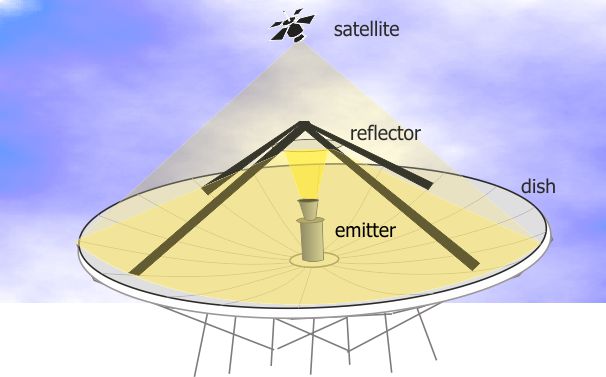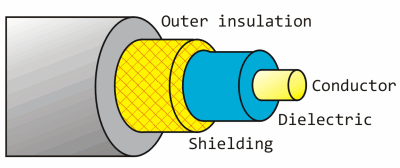Freesat reception - all about dishes
 Brian Butterworth published on UK Free TV
Brian Butterworth published on UK Free TV Satellite reception has both advantages and disadvantages compare with terrestrial (aerial) reception.
By using much higher frequencies (gigahertz, compared to terrestrial televisions megahertz) more transmission channels called transponders (the satellite equivalent of multiplexes) can be provided. For example, there are only six Freeview multiplexes, but Sky or Freesat users can access two hundred satellite transponders.
Aside from exceptional weather conditions (very heavy rain for example) digital satellite provides stable pictures and audio. Where Freeview transmitters are no more than 732 metres above sea level, the geostationary satellites used for television are 35,800,000 metres above the equator so reception is possible even where buildings, trees and hills make terrestrial reception impossible.

The downside of the transmitters being 22,300 miles up in the air is that the signals are very, very weak - so standard TV aerial is of little use. When the signals are sent to the satellites, huge dish transmitters are used to uplink the signal to the satellite. These are tens of metres from side to side, and feature an emitter that generates the signal, which is first bounced of a mirror (called a reflector) and then off the surface of the parabolic dish.

There are many satellites in the sky over the equator. Often these are in clusters over a particular position, for example there are four used for UK television are at 28.2 degrees east. There is another cluster over the 19.2 degrees east positions that are used for German television.
To receive these very weak signals from the satellite, it is necessary to use a dish for reception too. By using a reflective dish, this concentrates the signals onto a small device called a LNB. This is held in front of the dish by a metal arm.

The size of dish for reception is typically much smaller; often 60cm to 100cm in diameter, but the exact size depends upon the transmitting satellite transponder. To keep the transmission power levels down to levels that can be powered by the satellite's solar panels, each beam is focused on a particular area of the Earth's surface. If you are trying to receive the signal at the centre of this zone, a small dish is required. At the outer edges, you may need a 5 metre dish. Maps of these zones are provided by the satellite companies, and are called satellite footprints.
When the dish is installed it must be aligned carefully as the signal is very weak. The installer needs to know the inclination and the azimuth from the ground location to the satellite. If you install yourself you will find that there are markings on the dish that are used to point the dish in the correct position. It is important that the view of the satellite will not be blocked, so must take into account leaves growing on trees and potential building works.
For many people the LNB will have a single cable connected to it, however if you have Sky+ or a multi-room installation the LNB package will actually contain four receivers a quad-LNB. Unlike terrestrial television where you can split the aerial cable to feed more than one Freeview box or television set, with satelite reception you cannot. So, a Sky+ box with two receivers (so you can watch one thing and record another) has two cables connecting the box to the dish.
The cable that connects the dish to the receiver must be satellite grade cable. Whilst this looks superficially like the cable used to connect and aerial to a television, a higher grade cable is required for satellite reception.
Here is an image of a co-axial cable. This sort of cable is used to connect any type of receiving aerial to the reception equipment.

RG6, PF100 and PH100 are all types of coax cable that are suitable for the very weak signals that are received by a satellite dish. (The power is the same as you would receive from a one-bar electric heater on the moon).
The conductor in the centre passes the signals received from the dish to the set-top box. This is made from steel in RG6 cable, and from copper in the RF100 and PH100 types. This makes RG6 less suitable in the UK where rain can damage the cable.
The shielding is responsible for keeping unwanted external interference from damaging the signal. In the cheaper cable this will be a foil wrap, in better specified cables this is a braid (or mesh) of copper wires. The sheild in the RF100 covers 58% of the cable.
The non-conducting layer between the shield and the conductor is called the dielectric. This can be either a solid (RG6), foam (RF100) or air-spaced (PH100) dielectric. This makes the cables progressively more flexible (ie bendy without damage).
6:39 PM
Sheffield
On my SKY box I can watch all BBC variants and with a bit of manual tuning can get any ITV region. Does this facility apply to freesat - I imagine it would.
| link to this comment |
Steve's: mapS's Freeview map terrainS's terrain plot wavesS's frequency data S's Freeview Detailed Coverage
Steve: Yes, Which BBC regions are on satellite? | ukfree.tv - independent free digital TV advice lists the channel numbers.
| link to this comment |
12:07 PM
I have a sat. dish installed already with freesat on the main TV.
I would like to get freesat on other TVs in the house(it is already built in the TVs)but how can this be done ?
Sky suggested I buy another dish from them and pay for a sub. with multiroom for a year , then I can cancel and keep using it ? This will cost over £350.
I just want a good picture through the dish and to get the free channels !!
Please can you advise me ?Thank you.
| link to this comment |
Elizabeth: Yes, that sounds just like Sky.
A local installer will happily fit a quad-LNB to your dish and cables to each of your rooms for perhaps £100 or so.
All you need then is a Freesat box for each room, and they start at £30 each, Buy Bush BFSAT02SD Freesat SD Digital Box - Black at Argos.co.uk - Your Online Shop for Freesat digital set top boxes.
for example.
| link to this comment |
12:27 PM
Thank you !
If I have a tv with freeview preinstalled,would I need a box ?
| link to this comment |
Elizabeth: Yes, you need a Freesat box to use Freesat, they are not compatible with Freeview (which uses an aerial).
| link to this comment |
3:41 PM
Oh, right !
I thought they were the same thing?
Thank you so much for your help....just need to find a local installer!
| link to this comment |
Elizabeth: It's always best to ask friends and neighbours for recommendations for installers.
| link to this comment |
6:10 PM
i have a panasonic with both freesat and freeview built in when i go to watch bbc iplayer it some times plays all the programe or cut it short, i have to go back into iplayer and find the place it cut off at cannot work it out.so any help would be welcome
| link to this comment |
clive: Does it always happen at the same point? What is your broadband? How is it connected?
| link to this comment |